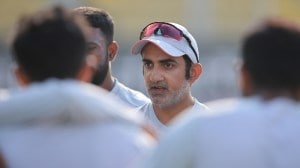The Insiders Account
Looking at a bin Laden portrait.
Growing Up Bin Laden
Jean Sasson,Najwa Bin Laden & Omar Bin Laden
OneWorld Publications
Pages: 397
Rs 399
In death,as in life,Osama bin Laden remained an enigma. The pictures released after the raid showed an ageing,haggard-looking man wrapped in a shawl watching television in his unremarkable Abbottabad house,quite removed from the image of a cold-blooded global terrorist,the worlds most dangerous man,the Saudi mulch-millionaire who financed and planned 9/11.
The truth is by the time he decided to leave Tora Bora and sneak into Pakistan,Osama was virtually penniless,living on charity from fellow travellers like Mullah Omar.
As the post-Abbottabad interrogation of Osamas youngest wife Amal Ahmad al Sadah goes on and the Osama mythmaking itself gets demolished,here is a look at a book that revealed his enigmatic life.
For all his fabulous inherited wealth,frozen by various governments post 9/11,Osama forbade his family of four wives and almost 20 children to use any modern conveniences like air conditioners,heating systems,electric ovens,televisions,computers,proper beds,sofas or even fans. Even in the opulent mansions that he bought in his pre-Afghanistan days,his wives cooked for the entire family on single-ring propane stoves and led lives of absolute self-denial when it came to personal wants and desires,sleeping on thin mattresses on the floor,denied modern medicines or doctors unless it was an emergency,and rarely stepping out into the outside world.
These and other such fascinating,even chilling,revelations are brought out in this book written about Osama with help from members of his family. Comprising recollections from Najwa,the first of Osamas wives,and her eldest son Omar,with some additions from the American author Jean Sasson,the book paints a picture of Osama as a charismatic figure who inspired fierce loyalty,but also an absolute tyrant and religious fanatic who taught his family to become tough and hardened survivors. He took them to mountains or deserts for entire days,without food and water,and got them,including the children,to dig holes and cover themselves in mud to survive the freezing temperatures. In fact,the reason why Osama had such a large family was his spoken desire to have foot soldiers for the Islamist jihad,an obsession since his college days.
Osama married Najwa,his cousin from Syria,when she was 15 and he 17,the only love marriage of his life. They lived in Jeddah before jihad consumed Osamas life. It was fortified by the Soviet invasion of Afghanistan. The family moved to Medina,but thanks to Osamas world view,now virulently anti-US,the Saudi government became his target for its pro-US stand. The bin Ladens,once among the kingdoms wealthiest families with instant access to the Saudi king,were banished. From then,the family would be on the move,first to Sudan,then Afghanistan where Osama was gifted his own mountain in Tora Bora by Mullah Nourallah,a prominent Pashtu leader.
While Najwas narrative is rarely critical of her husband,it is Omars memoir that forms the core of the book. He describes how his father built an army of jihadists who were given the same treatment as his own sons to toughen them up: Our father appeared to relish seeing us suffer. He said that we would end up being the stronger. Those with plenty would grow up weak men,unable to defend themselves. It is a fascinating coming-of-age-story of a boy who is groomed by his father to take over a worldwide terrorist enterprise,but who instead chooses to leave the family,return to Saudi Arabia and get a normal job. Najwa also leaves Osama and moves back to Syria when it gets too dangerous for them in Afghanistan. Three of his wives were with him,along with their children,when the Navy Seals stormed their Abbottabad house.
The book also has important signposts in the growth of al-Qaeda,including Osamas relationship with fanatics like Ayman al-Zawahiri,the Egyptian Islamist who is the new chief of al-Qaeda.


- 01
- 02
- 03
- 04
- 05





























